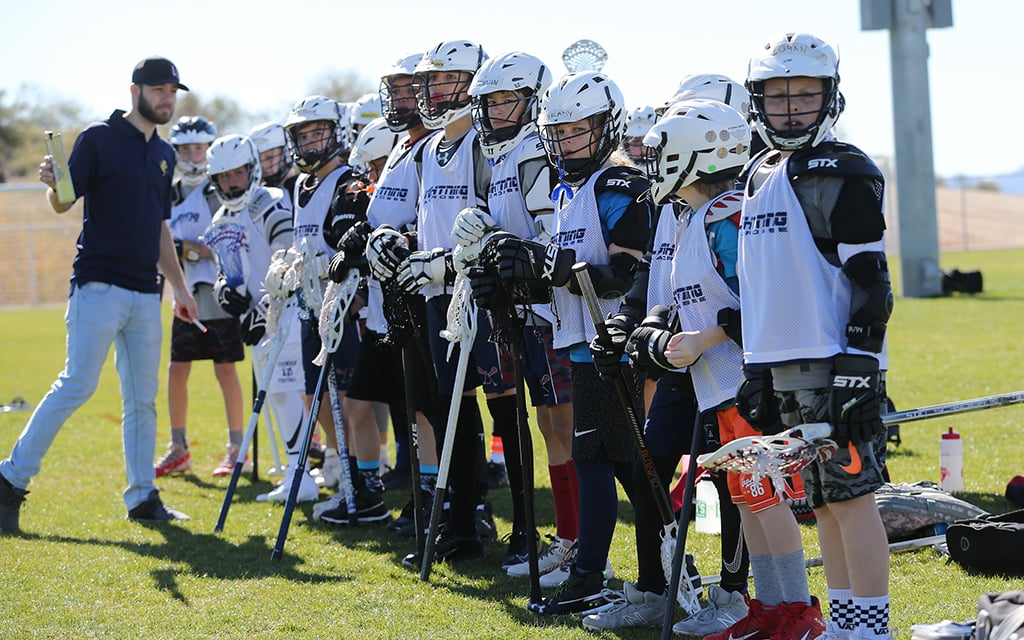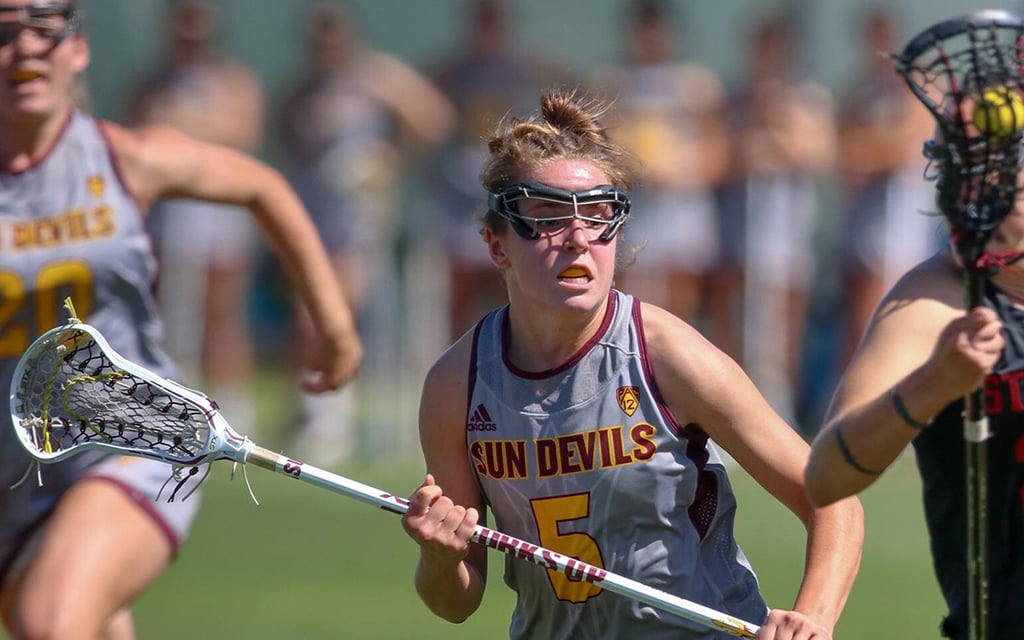PHOENIX – In a few pockets around Arizona, athletes suit up in helmets or goggles with an oddly shaped stick and take to the field. With the objective of putting a small rubber ball in a triangular-shaped goal, the athletes move at a staggering pace, sometimes leaving bruises on the shins of their opponents.
It might not be a common snapshot across the Valley sports scene, but that could be changing.
Lacrosse, a familiar sight on East Coast fields and the oldest organized sport in North America, has a history that stretches back to the early 12th century when it was played by groups of indigenous people.
In Arizona, the sport is still finding its footing.
Lacrosse is not sanctioned by the Arizona Interscholastic Association, so all teams at the high school level are clubs. Arizona State’s women’s program is the only NCAA Division I program in the state, as every other college team in Arizona plays at the club level.
Athletes at the youth, high school and many at the collegiate level are required to be members of USA Lacrosse, the sport’s governing body. Lyn Porterfield, USA Lacrosse regional director for the Pacific Southwest region, said there are about 1,000 high school athletes in Arizona who are registered with USA Lacrosse.
As with many sports, lacrosse participation numbers in Arizona took a dip during the COVID-19 pandemic, but people dedicated to the sport’s growth have worked hard to bring numbers back up.
The sport of lacrosse originated in the St. Lawrence Valley of southeastern Canada and Northeast US. The first game was played by the Algonquian tribe before spreading to other tribes in the Northeast and Great Lakes areas. Lacrosse has evolved immensely since the first games, which took place over multiple days and sometimes stretched for miles. Over hundreds of years, the sport has traveled to other parts of the world, including Arizona.
Migration from other parts of the country where lacrosse is more popular has greatly impacted participation in Arizona. Matthew McInrue – the commissioner of the Arizona Lacrosse League, the governing body for high school boys’ lacrosse – moved to Arizona from Indiana where lacrosse is more popular. McInrue had coached lacrosse in Indiana for years and wanted to stay involved in the sport after the move. In 2019, he reached out to the club lacrosse program at Brophy Prep and has been a coach since then.
Kyle Mox, the president of Arizona Youth Lacrosse, is also an Arizona transplant. Mox played lacrosse in Lansing, Michigan, and at the club level at Western Michigan University. When he moved to Arizona, he decided to get involved with the sport again, along with his son.
“You can’t get around the fact that you have a ton of transplants in Arizona,” Mox said.
While much of the growth of the sport in Arizona can be attributed to people from lacrosse hotbeds, Mox recognizes that this isn’t the most sustainable form of growth. In order for lacrosse to become a mainstream sport in Arizona, many more locals need to get on board.
Some Arizonans – like Doug Charters, president of the Arizona Girls Lacrosse Association – never pictured themselves involved in lacrosse. Charters never played growing up but became involved when his kids showed interest.
“I basically grew up with lacrosse through my kids,” Charters said.
As the sport expands throughout the state, more Arizonans will likely have similar experiences. The current goal is simply growth, but the long-term goal is to make that growth sustainable.
Interest in the sport tends to dip and rise. Charters said the growth is cyclical with high participation in some years and low participation in others, with certain groups of kids sticking with the sport and moving up through the ranks.
“I want to call it a success story, but sometimes it’s not,” Charters said.
On the boys’ high school side, McInrue said each year a team disappears, whether it’s a school’s entire program or a varsity or junior varsity team. Charters said on the girls’ side, there were four junior varsity teams added to existing programs, but two varsity programs were taken away. Charters and McInrue agree that lacrosse is still a niche sport in Arizona and the ebb and flow of participation reflects that.
Pinch points
There has been a trend of youth athletes specializing in specific sports from a very young age, leaving little to no room for experimenting with other sports later on. The flexibility of lacrosse at the high school level allows athletes to try a brand new sport, something that has become increasingly unusual.
Mox said he has about eight freshmen on his club team at Desert Vista who have never played before. This accessibility to the sport in high school when many other sports require years of experience attracts people to lacrosse, Mox believes.
“It’s a bit of a departure from the way that youth sports have gotten in the last few years,” Mox said.
Charters said that while this makes lacrosse more accessible, it cuts down on the opportunities for athletes in the state. Because there aren’t many opportunities in lacrosse until the high school club level, there is less commitment to the sport than there is to other sports that people have grown up in.
Next steps
The AIA, the governing body for high school sports in the state, does not currently sanction lacrosse. All high school lacrosse is played at the club level. Charters and McInrue agree that this is something that needs to change for the sport to broaden its reach. Charters is encouraged by the growth at both the youth and collegiate level in the state but believes an AIA sanction of the sport at the high school level is the next necessary step.
Mox is conflicted about the idea of an AIA sanction. While it would allow for funding from the schools and perhaps more teams across the state, it would also impose more restrictions. Currently, students attending schools with no lacrosse program can play for other schools. If lacrosse becomes an AIA-sanctioned sport, that would no longer be possible.
“Plenty of people in the lacrosse community are fine with the way things are, and I can see some virtue in that because it does impose a lot of restrictions and requirements,” Mox said.
If lacrosse were to become AIA-sanctioned, it could make it more difficult for athletes to play a multitude of sports. A timeframe would have to be agreed upon for the official lacrosse season, which could coincide with other sports that interest lacrosse players.
For a new sport to be added to the AIA’s radar, an administrator at a member school or an AIA board member must bring forward an action item. A few years ago, lacrosse was brought forward as an action item but was then demoted to a discussion item and no progress was made. Seth Polansky, AIA director of sports information, said there are currently no action items regarding lacrosse.
“If there’s any group out there that wants to add it, they just have to come to us,” Polansky said.
As the growth of the sport continues to ebb and flow, those who want to see it expand remain committed. Charters, McInrue and Mox are just a few of the people working to make lacrosse mainstream in Arizona and are doing so because they love North America’s oldest organized sport and the new community it creates.
“People build friendships just on the basis of their shared love of the sport,” Mox said.
Whether the next step is a sanction by the AIA or something else, the lacrosse community is alive in Arizona and is always looking to grow.


